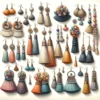Vintage Vibes: Capturing the Spirit of Retro Gaming Aesthetics
Welcome to “Vintage Vibes: Capturing the Spirit of Retro Gaming Aesthetics,” where we’ll take a journey through the nostalgic landscapes of classic video games and explore the timeless appeal of their distinctive visual style. In this immersive exploration, we’ll delve into the pixelated worlds of 8-bit and 16-bit graphics, uncover the secrets of retro gaming artistry, and celebrate the enduring legacy of gaming’s golden age. From the humble beginnings of arcade cabinets to the groundbreaking home consoles of the 1980s and beyond, join us as we discover the magic of retro gaming aesthetics and the role they play in shaping our collective gaming experience.

Prelude: Setting the Scene
In the early days of video games, graphical fidelity was limited by the technological constraints of the time. With primitive hardware and limited memory, developers were forced to work within tight constraints, resulting in graphics that were simple yet surprisingly expressive. Despite these limitations, the aesthetics of retro gaming have a timeless quality that continues to captivate players and inspire artists to this day. From the colorful sprites of Super Mario Bros. to the detailed landscapes of Final Fantasy VI, retro gaming aesthetics evoke a sense of nostalgia and wonder that transcends the boundaries of time and technology.
The Art of Pixel Perfection
Pixels and Polygons: The Building Blocks of Retro Gaming Graphics
At the heart of retro gaming aesthetics lies the humble pixel—a single point in a grid that forms the basis of all digital images. In the early days of gaming, pixels were used to create simple, blocky graphics that were limited in resolution and color depth. Despite these technical constraints, developers were able to create worlds that were rich in detail and charm, using clever tricks and techniques to make the most of the limited resources at their disposal. From the iconic characters of Pac-Man and Space Invaders to the lush environments of The Legend of Zelda and Metroid, retro gaming graphics offer a glimpse into a bygone era of creativity and innovation.
The Power of Nostalgia: Rediscovering the Magic of 8-Bit Art
In an age of high-definition graphics and photorealistic visuals, the simplicity and charm of 8-bit art continue to captivate players and artists alike. Nostalgic for the games of their youth, retro gaming enthusiasts have embraced the pixelated aesthetic, creating their own interpretations of classic characters and worlds in the form of fan art, animations, and indie games. Online platforms like social media and art-sharing websites provide a space for fans to showcase their creations, connect with fellow enthusiasts, and celebrate the timeless appeal of 8-bit art. Through their work, artists pay homage to the games that inspired them, keeping the spirit of retro gaming alive for future generations to enjoy.
The Evolution of 16-Bit Elegance
From 8-Bit to 16-Bit: The Next Level of Retro Gaming Graphics
In the early 1990s, a new generation of gaming hardware ushered in the era of 16-bit graphics, pushing the boundaries of what was possible in interactive entertainment. With improved processing power and expanded color palettes, developers were able to create more detailed and immersive worlds than ever before. Games like Sonic the Hedgehog, Super Mario World, and Final Fantasy VI showcased the capabilities of 16-bit graphics, featuring vibrant colors, smooth animations, and intricate level designs that captivated players and set new standards for visual excellence. The evolution of 16-bit graphics marked a turning point in the history of gaming, paving the way for the stunning visuals and immersive experiences of the modern era.
The Renaissance of Retro: Embracing 16-Bit Style in the 21st Century
In recent years, there has been a resurgence of interest in 16-bit style, fueled by a wave of nostalgia and a desire to reconnect with the games of our youth. Indie developers and artists have embraced the pixelated aesthetic, creating their own original games and artworks inspired by the classics of the 16-bit era. From platformers and RPGs to shooters and puzzle games, modern interpretations of 16-bit style offer a fresh take on retro gaming aesthetics, combining old-school charm with modern sensibilities to create something truly special. Through their work, creators pay tribute to the games that shaped their childhoods, keeping the spirit of retro gaming alive for new generations of players to enjoy.
The Charm of Retro Gaming Music
Chiptune Magic: The Soundtrack of Gaming’s Golden Age
In addition to their distinctive graphics, retro games are also known for their iconic soundtracks, created using the primitive sound chips found in classic gaming hardware. Composers of the time faced similar technical constraints to their graphical counterparts, with limited channels and polyphony at their disposal. Despite these limitations, they were able to produce music that was both memorable and evocative, using simple melodies, catchy hooks, and inventive arrangements to bring their worlds to life. From the infectious tunes of Super Mario Bros. and Tetris to the atmospheric soundscapes of Metroid and Castlevania, retro gaming music became an integral part of the gaming experience, enhancing immersion and emotional engagement in ways that few other mediums could.
The Resurgence of Chiptune: A New Generation of Retro Music
While the 8-bit era may be long gone, the spirit of chiptune music lives on in the hearts and minds of musicians and composers around the world. Inspired by the sounds of their favorite games, artists create their own original compositions using retro sound chips and synthesizers, paying tribute to the music that shaped their lives. From live performances and DJ sets to studio recordings and online releases, chiptune artists celebrate the legacy of retro gaming music in all its pixelated glory, bringing a modern twist to a classic sound. Through their work, they keep the spirit of retro gaming alive for a new generation of players, ensuring that the melodies of memory continue to resonate for years to come.
The Enduring Appeal of Retro Gaming Aesthetics
Preserving the Past, Inspiring the Future
As we look back on the history of video games, it’s clear that retro gaming aesthetics have a timeless quality that continues to captivate players and inspire artists to this day. From the humble beginnings of 8-bit graphics to the dazzling visuals of the 16-bit era, retro gaming aesthetics offer a glimpse into a bygone era of creativity and innovation that continues to shape the medium today. Whether it’s the pixelated charm of classic sprites, the intricate detail of 16-bit landscapes, or the infectious melodies of chiptune music, retro gaming aesthetics evoke a sense of nostalgia and wonder that transcends the boundaries of time and technology. As we continue to explore the magic of retro gaming, let us cherish the memories, celebrate the classics, and embrace the timeless appeal of vintage video games for generations to come.
Conclusion
“Vintage Vibes: Capturing the Spirit of Retro Gaming Aesthetics” is a celebration of the artistry, creativity, and nostalgia of classic video games. From the iconic pixels of 8-bit graphics to the lush landscapes of 16-bit masterpieces, retro gaming aesthetics have a timeless quality that continues to captivate players and inspire artists around the world. As we continue to explore the magic of retro gaming, let us cherish the memories, celebrate the classics, and embrace the timeless appeal of vintage video games for generations to come.


